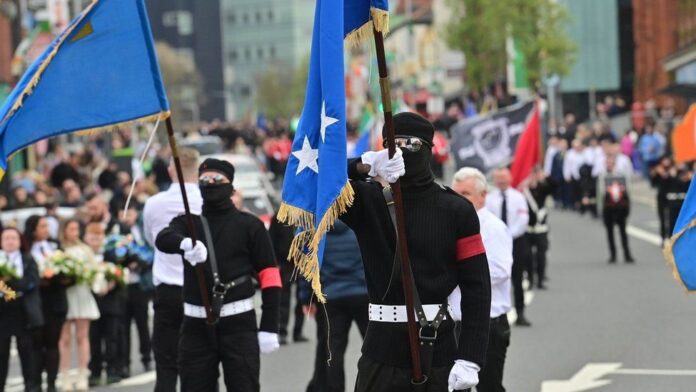The Good Friday Agreement (GFA) was signed on April 10th, 1998. Its 25th anniversary has been marked by the visits of US President Joe Biden and Bill and Hilary Clinton to Ireland, and a series of commemorative events. The GFA is trumpeted as a triumph of diplomacy and statecraft, and the Northern Ireland “peace process” is held up as an example for conflict resolution all over the world.
The reality is different. The governmental institutions created by the GFA have functioned for little more than 50% of the years since. The sectarian political parties (which represent the interests of one community only), still praised for their role in bringing 30 years of death and destruction to an end, confront each other daily in an endless cycle. For the working-class communities there is no real peace, and the promised prosperity never came. Military strategist Clausewitz once said that “war is politics by other means”. In Ireland the peace process amounts to a continuation of “the Troubles” by other means.
Managing Division
The GFA was a complex deal between the main political parties in Northern Ireland, and the British and Irish governments, designed to create the conditions for power-sharing government. An elected Assembly, with an Executive comprised of politicians from parties which represent both the Protestant and Catholic communities, has power to decide on matters which have been devolved to Northern Ireland by the UK government, such as health and education. It does not have tax raising powers.
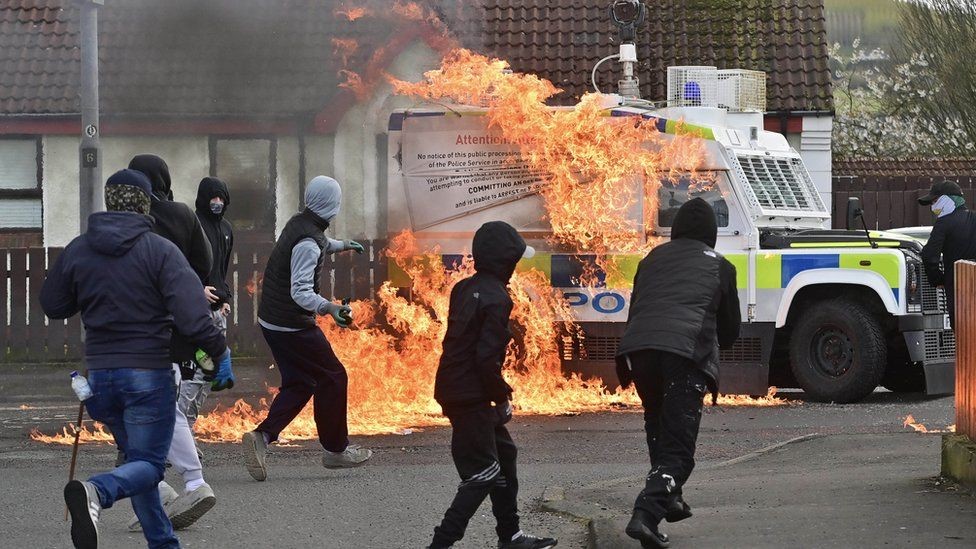
The GFA accepted division and sought to manage it, not to challenge it. The implementation of the GFA was fraught from day one. In the early years violence continued at high level. The worst atrocity of “the Troubles” occurred only weeks after the Agreement when 29 people and two unborn twins died in the Omagh bombing. There was continuing conflict over disputed Orange Order parade routes and feuds within and between paramilitary groups. The geographical separation of the two communities actually increased in these years as families were either intimidated from their homes or anticipating intimidation moved to areas where they felt safer. The “peace walls” (barriers build between communities) did not come down, rather more were built.
There was sharp disagreement between the sectarian parties over the decommissioning of arms held by the paramilitary groups, and over the control of policing. It took two years from the signing of the GFA before an Executive was formed. In 2002 the Executive collapsed after a police raid on the parliamentary building at Stormont lead to three Sinn Fein members being charged with intelligence gathering (one of those charged, Denis Donaldson, a senior Sinn Fein official, was later exposed as an informer and shot dead). For the five years from 2002 to 2007 there was no devolved government.
The worst rioting in some years took place in the autumn of 2005 when an Orange Order parade was stopped from entering a disputed area. Eventually new talks resulted in the “St Andrews Agreement” and for a decade Sinn Féin, the Democratic Unionist Party (DUP) and three other parties formed an administration which imposed austerity after the financial crash. There was a sharp increase in tension in 2012 and 2013 when the “flag protests” saw widespread street disorder which lasted for many months. With multiple issues threatening a further collapse inter-party talks were necessary and eventually new deals were done-resulting in the Stormont House Agreement in 2013 and the Fresh Start Agreement in 2014.
Despite this the Executive did eventually fell apart again in January 2017 when a scandal broke over the “Renewable Heat Incentive” scheme. Sinn Fein walked out and quickly other issues, especially Irish language rights, became more important blocks to renewed devolution than the heating scheme. It was three years before devolved government returned in January 2020 and then it only lasted until February 2022. The crisis on this occasion was caused by the DUP walking out in protest over the “Northern Ireland Protocol” (the post-Brexit arrangement between the EU and the UK). Taken together this means that the Executive has only been in place for about 50% of the time over the last 25 years and Northern Ireland now holds the world record for the longest time any jurisdiction has been without a government.
Agreeing to disagree
The “Agreement” was a deal between the main political parties-parties which thrive on sectarianism and act to increase division. Contentious issues were put to one side to allow a carve up of power and influence. There is little real agreement on anything (even the name of the agreement: for republicans and nationalists it is the “Good Friday Agreement”, for unionists the “Belfast Agreement”). There is disagreement on the meaning and content of the GFA and subsequent deals-the fractious rows over whether the DUP had or had not agreed to support an Irish language act being the most obvious example.
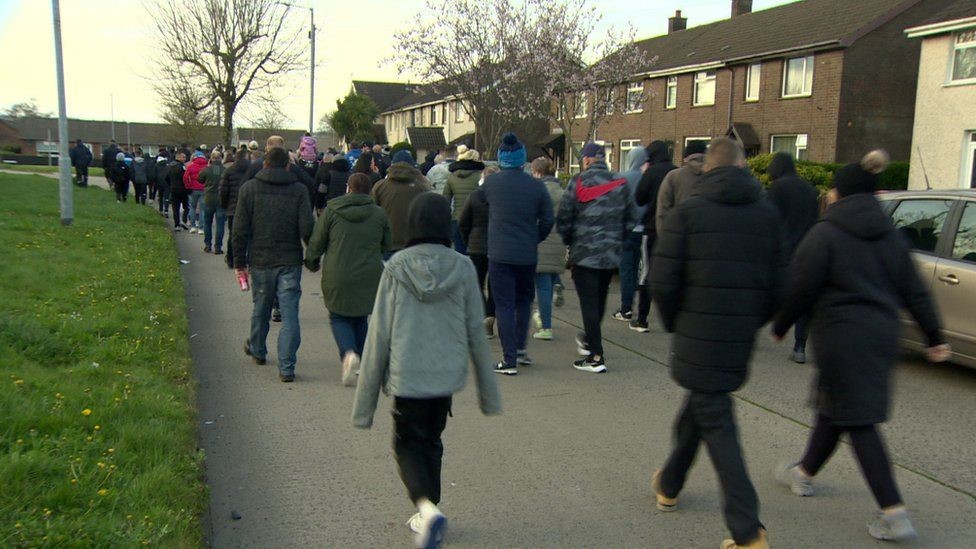
There have been significant changes since the late 1990s of course, most obviously the carnage which marked the three decades before 1998 has largely come to an end. In the 30 years from 1968 to 1998 over 3500 died as a result of politically motivated violence; in the 25 years since 165 have died. The continuing death toll illustrates only too well however that genuine peace remains elusive. There is continuing low-level sectarian conflict and paramilitary groups continue to recruit and remain armed and active. A leaked security report suggests that the main paramilitary groups in the Protestant areas, the Ulster Volunteer Force and Ulster Defence Association, have 12,500 members (equivalent to 400,000 or more in a more populous country such as the UK, France or Germany). The New IRA and Continuity IRA are against the GFA and maintain armed campaigns against the state but are capable of intermittent attacks only. The Irish National Liberation Army is a very visible presence in some Catholic communities.
The paramilitary groups seek credibility and exercise control through the meting out of rough justice to young people who are alleged to have engaged in criminal behaviour, shattering limbs by shooting (“kneecapping”) or beatings. They engage in shows of strengths, including on the day of the GFA anniversary itself. The Loyalist paramilitaries engage in drug dealing and other criminal behaviour-over the last two weeks there have been dozens of attacks on homes in the North Down area as rival groups feud over territory.
Despite the on-going effects of paramilitarism the relative peace is cherished by most working-class people. They have no illusions however, and have given up on the long-promised but never delivered “peace dividend”-the myth that an influx of investment and good jobs would cement peace. The proportion of the population not in work is higher than in England, Scotland, Wales or the south of Ireland and average pay is lower. Social conditions in the most deprived communities, which saw the worst of the violence, have not improved. Poverty is endemic, and mental health problems and addiction blight many lives.
A window of opportunity
In 1998 the Socialist Party explained that the GFA would not solve the problems facing working people but, despite this, called for a ‘yes’ vote in the twin referendums, North and South, which were called to endorse the Agreement. A rejection of the Agreement risked a spiral towards renewed and potentially more intense armed conflict within a short period of time. In contrast, a “yes” vote would potentially open a window of opportunity during which class-based and anti-sectarian politics might find a firmer foothold, especially when the sectarian parties were exposed as pro-capitalist once they were in power. Over 70% of voters in Northern Ireland voted the Agreement but the breakdown of the vote was a warning for the future: it is estimated that 97% of Catholics supported the Agreement, but only 53% of Protestants.
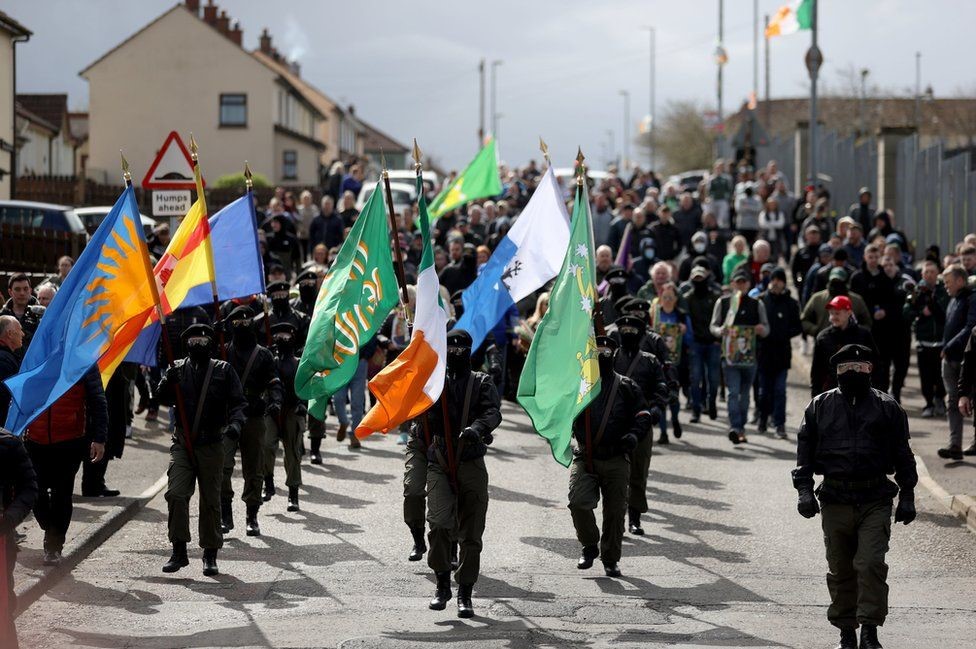
Whilst the credit for the GFA was given to sectarian parties-in other words the forces which had contributed to the outbreak of conflict in the first place-the impetus for the peace process actually came from below, not above. In the 1980s and 1990s, trade unionists mobilised tens of thousands of working-class people against the campaigns of the paramilitaries and against state repression. Workers and young people responded to the lead of the trade unions because they were weary of decades of violence. Only a minority actively supported the paramilitary campaigns in either community at this point. It was becoming increasingly obvious to the leadership of the IRA that they could not win their “long war”. The IRA could sustain its campaign almost indefinitely but it was increasingly contained by the state forces and was taking heavy casualties-it lost 19 members, shot dead by the British army or police, in 1987 and 1988 alone. Sinn Féin’s vote had plateaued and, in 1992, Gerry Adams lost the West Belfast Westminster seat to the SDLP. Sinn Fein drew the conclusion that the actions of the IRA were a fetter on its further growth and sought terms on which it could draw its campaign to an honourable end.
Before and after the signing of the GFA, the energy of the strikes and mass rallies for peace should have been harnessed and brought behind a new, trade-union backed, left political party. The weight of the trade unions and the energy of young people could have built a united, workers peace process. The sectarian parties and the paramilitaries could have been challenged and a real alternative for all workers, both at the ballot box and in the communities, created. History turned out differently. Rather than challenging the sectarian parties most of the trade union leaders provided cover for both their divisive policies and their pro-capitalist programmes.
Workers’ movement must offer an alternative
Today the challenge for the workers movement remains the same. History does not stand still and the political, social and economic conditions that made the GFA possible are changing fast. The Brexit vote has amplified division, but the real game-changer is the growth of the Catholic population. The very existence of Northern Ireland is now in question and there is an intensifying debate as to the way forward. For Sinn Féin, it is simple: demographic change means that a united Ireland is inevitable and how it will be achieved is through a “border poll”. In fact a border poll will inevitably increase tension and risk conflict. It will not provide a solution.
There is a way forward. Historically, the workers’ movement-comprised of the trade unions and anti-sectarian, working-class political parties-has been the vehicle by which old and divisive ideas are challenged. There have been many periods when united workers’ struggles pointed the way to a different society. Even at the most difficult times workers’ unity has not been broken. There were thousands of industrial disputes over the years of “the Troubles” but despite the turmoil outside the factory gates, there is not one recorded example of any dispute being defeated by sectarian division. The workers’ movement gave voice to the widespread anger and revulsion at sectarian killings from both sides. If the trade union leaders had raised the banner of a new, working-class party, then the paramilitaries could have been not just checked but defeated.
The historic failures of the leaders of the workers’ movement in 1968-1970 opened the way to the dominance of the sectarian forces which took us into the tragedy of “the Troubles”. In the 1990s, opportunities were again missed to create a mass alternative. If we are to avoid new tragedies in the future, it is vital that an alternative is built now. Many young people are already in revolt against the social conservatism of the main parties. The surge in (British) Labour Party membership in the North in the wake of the election of Jeremy Corbyn as leader-from several hundred to over 3,000-demonstrates that there is a thirst for a political party which is socialist and anti-sectarian in outlook. The recent upsurge in strike action has drawn more workers into the unions, and emboldened activists.
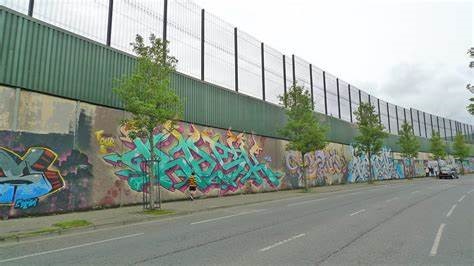
The workers movement should not draw negative conclusions from the failure of the GFA. Rather, we should draw the optimistic conclusion that workers’ unity in struggle on economic issues demonstrates what is possible. If the working-class were to form its own mass, political party, independent of the sectarian and pro-capitalist parties, the cycle of violence, poverty and misery can be broken. Such a party will inevitably draw on the real lesson of the Northern Ireland peace process: there is no solution under capitalism. Only in the struggle for a socialism will we create the conditions for lasting peace, a shared future and an end to poverty and insecurity.


